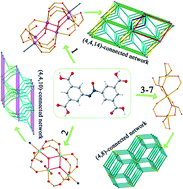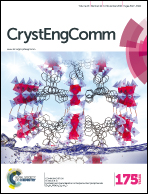Metal nuclearity affects network connectivity: a series of highly connected metal–organic frameworks based on polynuclear metal clusters as secondary building units†
Abstract
Seven novel highly connected metal–organic frameworks (MOFs), formulated as [Co7(aobtc)3(bpy)2(μ3-OH)2(μ2-OH2)2(H2O)4]·4H2O (1), [Ni5(aobtc)2(bpy)2(μ3-OH)2(H2O)6]·4H2O (2), [Zn3(aobtc)2]·H2bpy·H2O (3), [Zn3(aobtc)2]·H2bpp·H2O (4), [Cd3(aobtc)2]·[Me2NH2]2·3H2O (5), [Co3(aobtc)2]·H2bpp·H2O (6) and [Mn3(aobtc)2]·H2bpy·2H2O (7) (H4aobtc = azoxybenzene-3,3′,5,5′-tetracarboxylic acid, bpy = 4,4′-bipyridine, bpp = 1,3-bis(4-pyridyl)propane) have been synthesized and characterized by elemental analyses, IR spectra, single-crystal X-ray diffraction, powder X-ray diffraction, and thermal analyses. Compound 1 is a 3D (4,4,14)-connected self-penetrating framework with (46)2(45·6)(430·526·631·74) topology based on hexanuclear clusters as 14-connected nodes. To our knowledge, compound 1 represents the highest connected self-penetrating topology presently known in the entangled system. Compound 2 displays a trinodal (4,4,10)-connected network with (46)(45·5)(410·518·612·75) topology based on tetranuclear clusters as 10-connected nodes. Compounds 3–7 exhibit (4,8)-connected flu nets based on trinuclear clusters as 8-connected nodes, and these five MOFs show similar structures but different pore volumes mainly associated with the change of the species of guest molecules. Structural analyses of 1–7 demonstrate that increasing the metal nuclearity is a practical method to obtain highly connected coordination networks based on metal clusters as nodes. In addition, the magnetic properties of 1, 2, 6, and 7 and the luminescence properties of compounds 3–5 have also been studied.


 Please wait while we load your content...
Please wait while we load your content...